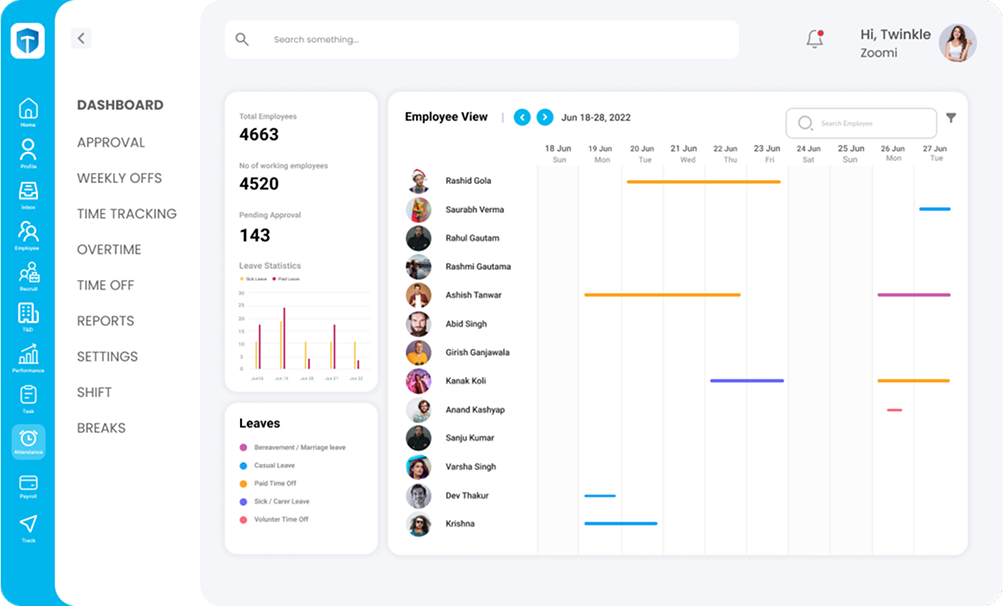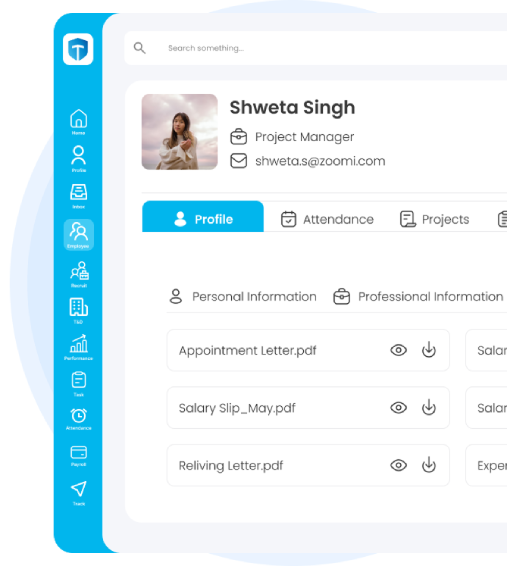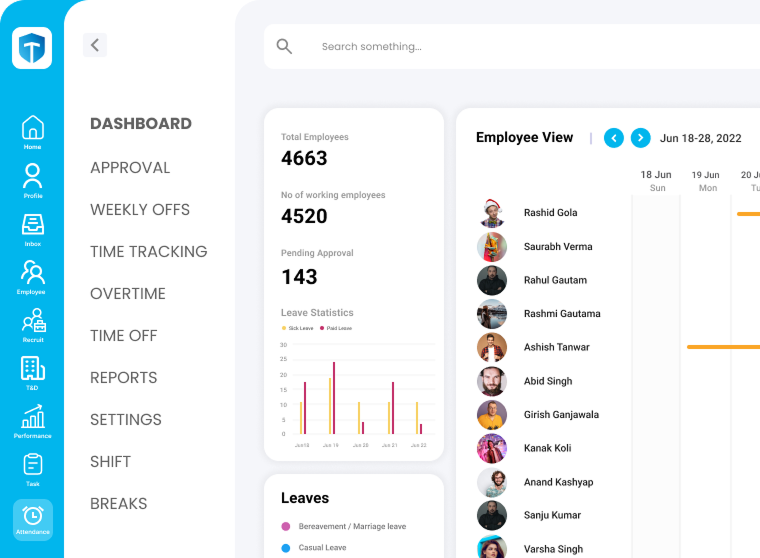Performance Management System
A structured approach to track goals, assess performance, and drive employee growth.
A Performance Management System aligns roles with business goals, tracks progress, and enables continuous feedback for better appraisals and employee growth.
What is a Performance Management System?
A Performance Management System (PMS) gives teams clear goals, ongoing feedback, and easy progress tracking. It replaces once-a-year reviews with continuous support and visibility.
 Goal setting and alignment
Goal setting and alignment Real-time progress tracking
Real-time progress tracking Regular check-ins and feedback
Regular check-ins and feedback
 Performance reviews and ratings
Performance reviews and ratings Development plans and appraisals
Development plans and appraisals

Why Is Performance Management Important?
Performance management shapes how people work, grow, and contribute every day. A well-designed system keeps everyone on the same page, makes feedback fair, and helps teams perform their best.
 Alignment with organisational goals
Alignment with organisational goals Clear expectations and growth paths
Clear expectations and growth paths Early identification of high and low performance
Early identification of high and low performance
 Regular feedback and recognition
Regular feedback and recognition Stronger accountability and transparent appraisals
Stronger accountability and transparent appraisals
Core Functions of a Performance Management System
Goal and Objective Setting
Continuous Feedback and Check-ins
Performance Reviews
360-Degree Feedback
Appraisal and Compensation Planning
Development Plans and Training
Dashboards and Analytics
Goal and Objective Setting
Define and assign performance goals linked to team or company objectives.
 OKRs (Objectives and Key Results)
OKRs (Objectives and Key Results) KPIs (Key Performance Indicators)
KPIs (Key Performance Indicators)
 SMART goal templates
SMART goal templates Alignment with department-level priorities
Alignment with department-level priorities

Continuous Feedback and Check-ins
Move beyond once-a-year reviews with regular conversations.
 Weekly or monthly 1:1 check-ins
Weekly or monthly 1:1 check-ins Manager and peer feedback
Manager and peer feedback
 Progress updates and blockers
Progress updates and blockers
 Real-time feedback logging
Real-time feedback logging

Performance Reviews
Conduct structured, data-driven performance assessments.
 Mid-year and annual appraisals
Mid-year and annual appraisals
 Self-assessments and manager evaluations
Self-assessments and manager evaluations
 Customisable review forms
Customisable review forms Weighted scoring based on goals, competencies, and behaviour
Weighted scoring based on goals, competencies, and behaviour

360-Degree Feedback
Collect feedback from different people to gain a comprehensive view.
 Peer reviews
Peer reviews
 Upward feedback (employee to manager)
Upward feedback (employee to manager)
 Cross-functional input
Cross-functional input
 Anonymous response options
Anonymous response options

Appraisal and Compensation Planning
Link performance outcomes to salary changes, bonuses, or promotions.
 Performance ratings tied to compensation decisions
Performance ratings tied to compensation decisions Rating employees on a curve (if applicable)
Rating employees on a curve (if applicable)
 Linking pay to employee performance
Linking pay to employee performance

Development Plans and Training
Turn performance results into training and development plans.
 Individual development plans (IDPs)
Individual development plans (IDPs) Check training needs
Check training needs
 Learning and development recommendations
Learning and development recommendations
 Tracking of completed training or certifications
Tracking of completed training or certifications

Dashboards and Analytics
Monitor performance trends across individuals and teams.
 High and low performer distribution
High and low performer distribution
 Goal completion rates
Goal completion rates
 Review cycle completion tracking
Review cycle completion tracking
 Attrition risk indicators based on performance
Attrition risk indicators based on performance

Benefits of Using a Performance Management System
A strong Performance Management System brings clarity, trust, and growth to the workplace. It helps organisations set clear expectations, support employee development, and make smarter decisions with reliable data.
 Clear criteria and feedback
Clear criteria and feedback Regular check-ins
Regular check-ins Visibility into goals
Visibility into goals Identify training needs
Identify training needs
 Spot high-potential talent
Spot high-potential talent Data-driven planning
Data-driven planning
How Performance Management Supports the Employee Lifecycle
A good Performance Management System supports employees through every stage of their journey. It helps organisations build trust, motivate teams, and guide long-term success.
Industries That Benefit Most from PMS
Performance Management Systems help organisations set expectations, track results, and develop their teams in a structured way. They’re especially useful in industries where clear goals, feedback, and consistent quality matter.
 IT and Technology
IT and Technology Professional Services
Professional Services Manufacturing
Manufacturing
 Retail and Hospitality
Retail and Hospitality Healthcare
Healthcare

FAQs
01. Is performance management the same as appraisal?
Not quite. Appraisal is just one part of performance management. A PMS includes goal setting, feedback, development plans, and ongoing tracking alongside appraisals.
02.What are OKRs and KPIs?
OKRs (Objectives and Key Results) focus on broader goals and measurable outcomes. KPIs (Key Performance Indicators) are specific metrics used to measure performance in particular roles.
03.How often should performance reviews happen?
Best practice includes quarterly check-ins, mid-year reviews, and an annual appraisal, supplemented by regular feedback sessions.
04.Can employees set their own goals?
Yes. Many systems allow for collaborative goal setting, where employees suggest goals and managers approve or refine them.
05.What happens after a performance review?
The review often leads to a discussion around progress, potential areas of improvement, and action plans for the next cycle. It may also result in decisions around salary revision, role changes, or training.






